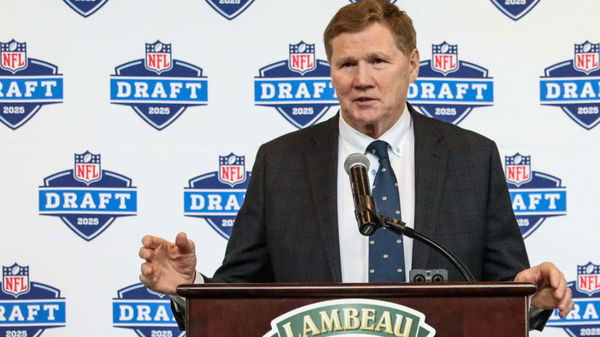

The NFL Draft is finally here; the countdown is almost over. After weeks of wild free agency moves, it’s time for NFL teams to shift focus—now, it’s all about the draft. Scouts have done their homework. Fans have made their mock drafts. The media’s buzzing. And finally, this weekend, the moment arrives. For 257 NCAA stars, their lifelong dream becomes reality—their name, called on the biggest stage.
Each of the 32 NFL teams gets one pick per round—unless trades shake things up. The draft order flips the standings, giving the worst team first dibs and the champs the final say. Tennessee holds the No. 1 pick after a rough season and a QB room full of question marks. With Will Levis still unproven and Mason Rudolph gone, all signs point to the Titans going QB. But don’t anticipate a quarterback frenzy like last year’s six picks in the top 12; this draft class has strong talent at the top but lacks depth at the QB position.
Cam Ward and Shedeur Sanders are the headline acts, with Ward now the favorite after torching defenses for over 4,300 yards and 39 TDs. Sanders dazzled with a 74% completion rate and led CU to a strong finish. Yet the buzz isn’t all under center. Travis Hunter—part CB, part wideout, full-on unicorn—snatched the Heisman and turned heads league-wide. Behind him, Abdul Carter leads the defensive charge. And don’t sleep on trench beasts like Mason Graham and Will Campbell. It’s a class full of versatility, flash, and big potential.
ADVERTISEMENT
Article continues below this ad
NFL Draft eligibility rules for college athletes
The NFL Draft isn’t just a selection show—it’s a spring spectacle built on strategy, suspense, and split-second decisions. According to the league’s CBA, players can’t go pro until 3 years after their high school class graduates. If they’re ready early, they’ve got to “opt in” for early eligibility.
According to NFL rules: “To be eligible for the draft, players must have been out of high school for at least three years and must have used up their college eligibility before the start of the next college football season. Underclassmen and players who have graduated before using all their college eligibility may request the league’s approval to enter the draft early.”
Once players are eligible for the draft or declare early, the Player Personnel staff coordinates with teams, agents, and schools to confirm their status. They also work with these parties to ensure NFL rules are followed during Pro Days and private workouts. During the draft itself, this staff verifies that every player selected meets the eligibility requirements.
Then comes the big stage: 3 days, 7 rounds, and dreams waiting to be called. It all kicks off Thursday night with the glitz and glam of Round 1. Each team has 10 minutes to make their pick, and the pressure’s sky-high. Friday brings rounds two and three, while Saturday speeds through rounds four to seven. Miss your time? Another team might swipe your star.
However, behind the scenes, the action is even more intense. Every franchise has boots on the ground at Selection Square, staying locked in with the war room back home. Once a decision is made, it’s scribbled on a card—name, school, position—and handed off to a runner. You know, that card is gold. The runner dashes it over to the league staff, locking in the pick and resetting the clock. Another runner hits up the next team to prep them for their moment. Well, timing is everything; one delay could change a team’s future.
What’s your perspective on:
Will the Titans' No. 1 pick be a game-changer or another QB bust in the making?
Have an interesting take?

ADVERTISEMENT
Article continues below this ad
As soon as the card’s in hand, the NFL’s machine takes over. A rep radios the pick to league HQ, updating every franchise instantly. Meanwhile, the card is delivered to the NFL’s VP of player personnel. He double-checks the details before sending it to the stage. Then, boom—the name is revealed to the world. Fans cheer, players cry, and the journey begins. It’s not just a draft—it’s a carefully choreographed football opera, where every second counts.
ADVERTISEMENT
Article continues below this ad
When can a sophomore enter the NFL Draft?
In the NFL, timing is everything—even when it comes to declaring for the draft. While most players wait until they’ve wrapped up their college eligibility, some underclassmen decide to make the leap early. Sophomores can enter the NFL Draft only if they’ve been out of HS for 3 full seasons and are granted special eligibility. These players must file a petition with the league to forfeit their remaining NCAA years. Thanks to the NCAA’s COVID exemption, some have an extra year, but they must officially opt out to go pro. It’s a bold move, and one that needs careful timing.
To help underclassmen test the waters, the NFL introduced a “soft” deadline of January 6. It allowed early hopefuls to submit their paperwork but still withdraw by January 9th if they changed their minds. The main application deadline was January 15th—with no take-backs after January 18th. Players in the CFP title game got extra time, with a special ‘championship’ deadline on January 24th. Those players had until January 27th to change their minds. The final, official list of approved underclassmen reached NFL offices—and the public—on January 25th. Until then, no name was truly locked in.
ADVERTISEMENT
ADVERTISEMENT
ADVERTISEMENT
ADVERTISEMENT


Will the Titans' No. 1 pick be a game-changer or another QB bust in the making?